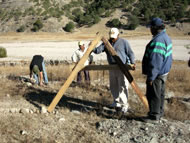AMONG THE ENGLISH-SPEAKING settler societies – the US, Canada, Australia, New Zealand – an irrational but powerful myth still prevails: divinely inspired colonists wrested lands occupied by native peoples and bestowed the mixed blessings of civilisation on them. The rationalisation for dispossession was and still is that these ‘primitive’ peoples were not making productive use of their lands. What they did not know, and still do not, is that they took over lands that were largely shaped and maintained by Indigenous peoples through extensive and intensive land-care practices that enabled them to not only survive but thrive.
Enter the 21st century. The work of Indigenous dispossession is about to be completed. The last great global land-grab and Indigenous asset-stripping is happening as I write. Land values are dramatically increasing with demand for biofuels, plantation monocultures for carbon offsets, and transfat substitutes such as palm oil. As demand increases, so does the rate of loss of Indigenous land assets and livelihood options. Adding to these losses are further losses of homelands set aside by big environmental NGOs and Third World government elites for conservation reserves and national parks through forced evictions.
Disappearing with this land and its resources is an incalculable wealth of stewardship experience and knowledge. While the developed West is scrambling for solutions to global warming, Indigenous peoples are receiving the brunt of the effects of climate change caused by industrialisation, especially in the Arctic, the Indo-Pacific oceans, high mountain ranges, and arid lands. Ignored in the global debate are Indigenous cultures that have survived and thrived over uncountable generations of ice ages, extensive droughts and floods, and catastrophic fires – while many so-called civilisations have collapsed. This is because native peoples have a proven record of adaptive resilience to environmental change. In North America we call native adaptability ‘Indiangenuity’. It is something the West desperately needs. It is a local, bottom-up process of adapting to the changing environment.
INDIGENOUS PEOPLES PRESENTLY occupy 22% of the Earth’s land surface, steward 80% of remaining biodiversity, and comprise 90% of cultural diversity. These biological riches are still there because native cultures have exercised restraint in harvesting and reciprocity in caring for the resources that sustain life. The native peoples’ worldview is kincentric. Plants and animals are our relatives. They take care of us and so we take care of them as in a family (kin). This kincentric relationship is at the core of the difference between Indigenous cultures and modern developed societies. The Navajo have 348,000 verbs to describe relationships. There are no words in Indigenous languages for domination, hierarchy, or control. These traditional values are still alive, but they are disappearing faster than glacial ice caps are melting.
THE RIO CONVENTION on Biological Diversity affirmed that Indigenous cultures protect biodiversity and should be compensated for their sustainable practices. But the US-dominated Uruguay round of GATT in the same year effectively shut out Indigenous peoples from any protection or compensation. In the meantime the world is losing viable Indigenous cultures that are the stewards of genetic diversity and a source of wisdom to mitigate climate change. These Indigenous communities have proven capability for sustainable agroecology and agroforestry – something the world needs as an alternative to unsustainable and unaffordable modern agribusiness.
With the loss of Indigenous communities the world will also lose the continuing contributions of native knowledge to natural medicine, sustainable agriculture, commonly eaten natural foods, and fisheries. All of this Indigenous know-how is exploited by multinational corporations, whose short-term development strategies are the root cause of climate chaos and poverty for Indigenous peoples, as well as for other people in general.
Why not hold the big corporations accountable for the damage they inflict on Indigenous peoples who are suffering from climate change that they didn’t cause? Where is the accountability? Why not support Indigenous reserved treaty rights, secure land tenure, co-management of native homelands, and access to traditional resources? All such rights are recognised in existing national and international laws and treaties, but they are simply ignored.
RESTORING RIGHTS OF and respect for Indigenous cultures is not about some romantic return to the past: it is about the survival of all humans on planet Earth and it is about the recovery of the collective heritage of our species. We lose the native wisdom at our peril. •








